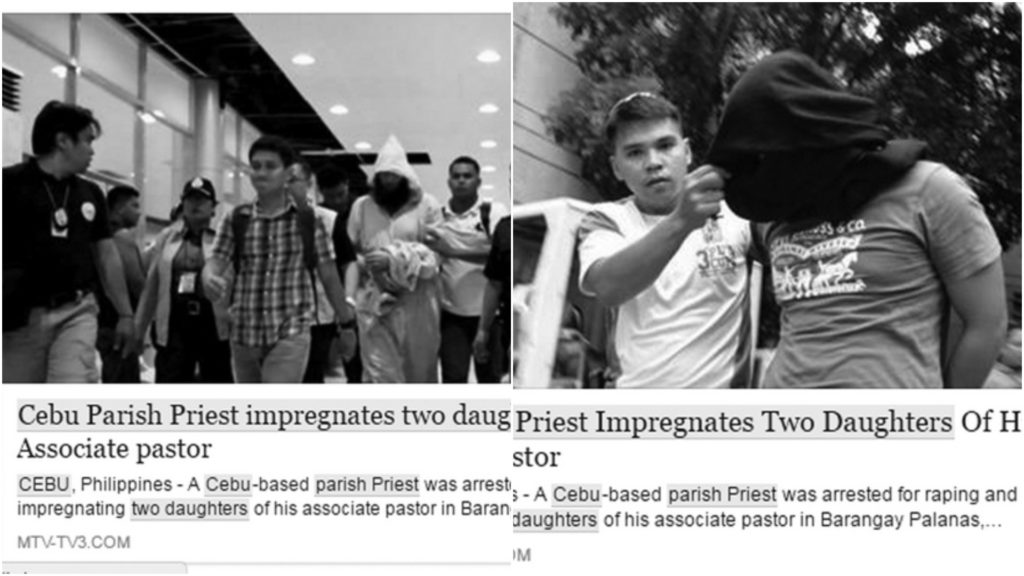
TRUTH VS. DECEIT
As the lights turned red, Fr. Roberto “Bobby” Ebisa stepped on his car brakes and calmly glanced at his cellular phone.
The text message was too hard to ignore.
“Have you any idea about this priest assigned in Alcantara who was arrested for raping two young women?,” it read.
Ebisa was taken aback and became really disturbed that he forgot that he was in the middle of the road.
There was no mention of any name.
“But I know the priest alluded to because we both grew up in the same place,” said Ebisa, a native of Barangay Valladolid, Carcar City, 42 kilometers south of Cebu City.
The drivers behind him honked their horns when the traffic lights switched to green, but Ebisa seemed not to notice.
He remained uneasy even as he celebrated Mass when he arrived at the church.
“I’m sure he could not do what he was accused of, but I just could not take it off my mind,” a worried Ebisa said.
After the Mass, the priest wasted no time to validate the report from his sources.
Lo and behold, the news which bothered him for hours was entirely false and concocted to create a non-existing circumstance.
Relief trickled through Ebisa when he learned.
False news
The report entitled “Cebu parish priest impregnates two daughters of his associate pastor” was so engaging that it received several thousands of social media shares, comments, and likes since it appeared on March 8, 2017.
Although fictional, the story succeeded in infuriating people.
Attacks and criticisms came in waves; while insults were hurled to express disdain, to mock and disgrace, not only the unnamed priest, but the Catholic Church as an institution as well.
As it has around the world, the digital space in the Philippines has become a swamp of fake news, treachery, bullying, and harassment.
They have polluted public discourse and have become a factor in influencing political developments.
As more and more fake content is hitting the web, many more people are getting deceived, and writers of fake news are earning more and more money.
Undoubtedly a dangerous trend, fake news has spread across social media like wild fire. It has either amused, confused, or ruined people’s lives.
From click-baiting headlines, false quotes attributed to real people, genuine content taken out of context, a doctored photo, or a hyperbolic report, fake news are deliberately made up to mislead, or masquerade as credible news.
Alarming
Ellen Tordesillas, president of Vera Files—an independent organization that undertakes in-depth reporting on current Philippine issues and monitors misleading claims circulating online, said that the proliferation of fake news has become so alarming that the group could hardly keep up with the production of lies on social media.
“There’s just plenty of fake news going around now, and so many people are clicking and sharing online stories one after the other, without even knowing if these are true or not,” she told Cebu Daily News.
The term “fake news,” she said, is an oxymoron as it contradicts itself.
“One of the attributes of news is truthfulness and fairness. When you say fake news, it’s a lie. So how can it be news? But as it is, that has become the common word we use now to describe lies being produced to deceive people,” she explained.
Amid the spread of falsehood, Tordesillas called on Filipinos to wake up, fight all forms of deceit, and rediscover the ways of truth.
“When we were still kids, we were taught at home, in school, and in church that anything that is a lie and untrue is bad. There is supposed to be no place for dishonesty and there ought to be no place for fake news. Truthfulness is very important, and all of us must always value the truth,” she said.
Mixed emotions
Although he was not identified in the story, Fr. Aeolus Villar, the parish priest of St. Augustine Church in Alcantara town, said he had mixed feelings when he learned about the controversial article that mentioned his parish.
“My parishioners told me about it. (At first), I was laughing at it because I knew it wasn’t true. But at the same time, I was anxious of what people who do not personally know me think,” said Villar who, prior to the fake article, had never been involved in any controversy in his 20 years as priest.
Tale of deceit
In the story posted on mtv-tv3.com and meganews360.com — two unpopular websites that claimed to be reputable sources of news and other information, a priest in Alcantara town, Cebu, was said to have been arrested and detained by the police for allegedly raping and impregnating his “pastor’s” two daughters aged 14 and 16 years.
The undated report quoted a certain Maria Jared Llenos of the Women and Children Police Desk as claiming that the alleged rape occurred in “October,” when the supposed victims were serving the priest at his residence.
Quoting Llenos, the report further claimed that the priest allegedly threatened the victims not to tell anyone about it or he would kill them.
Another alleged source, SPO1 Artemio Cababat, was reported to have said that they found it hard to get information or additional details from the victims who were afraid of the suspect.
Online, the story became a hot topic which ignited social media outrage while generating vile and nasty remarks against the Catholic Church.
But the big problem was that all the reactions were brought about by a narrative which was simply concocted.
“That is fake news. It’s fictional and did not even exist,” said Senior Insp. Rose Marie Acupinpin who served as chief of the Alcantara Police Station when the story came out last year.
The police official said she and her team were surprised when they read the report because they never encountered such a complaint.
Llenos and Cababat, who were quoted in the article, denied issuing any statements much more being interviewed about the alleged issue.
“They were totally shocked because their names were stated in the report and yet they were never interviewed on that matter,” Acupinpin said.

Two websites use these photographs to depict what seemed like the priest’s arrest. The left photo is actually that of the arrest of a police officer named Ronald Sacan, while the other photo shows Australian Islamist preacher, Musa Cerantonio, being escorted by authorities after he was arrested in Lapu-Lapu.
Wrong photos
Not only that.
The photograph used by meganews360.com to depict what seemed like the priest’s arrest turned out to be that of a police officer named Ronald Sacan who was arrested in 2015 for allegedly sniffing shabu inside a drug den in Dumanjug town, southwest Cebu — some 26.9 kms away from Alcantara.
The photograph originally belonged to Sun.Star Cebu.
On the other hand, mtv-tv3.com used a photo of an Australian Islamist preacher, Musa Cerantonio, who was arrested in Lapu-Lapu City in 2014 for allegedly recruiting foreign fighters to join the Islamic State terror group, to make it appear that he was the arrested priest in Alcantara.
The photo was taken by Edwin Llobrera and was originally used by Rappler.
“To set the record straight, we never received any complaint against any priest, particularly in our town,” Acupinpin said.
Smear campaign
Acupinpin believed that the fabricated report was meant to smear the reputation of priests and discredit the Catholic Church.
“I never thought fake news exists. But here they are,” she said.
And even after over a year has lapsed since it made its way to cyberspace, the tale continues to spread online, infuriating individuals and sowing hatred among the people.
Acupinpin noted that the dubious article resurfaced exactly a year after it was originally posted online in March 2017.
“If we don’t do anything about it, this might be reposted and disseminated every year,” she lamented. (To be continued.)
Disclaimer: The comments uploaded on this site do not necessarily represent or reflect the views of management and owner of Cebudailynews. We reserve the right to exclude comments that we deem to be inconsistent with our editorial standards.
